Last updated on
Discover the top football chalkboard ideas to elevate your coaching strategies, improve team performance and enhance overall game understanding in this insightful blog post.
Football is more than just a game; it’s an art form. And just like any other artist, a football coach needs the right tools to create their masterpiece on the field.
That’s where the football chalkboard comes in. This simple yet powerful tool can help coaches draw up plays and strategies that can make all the difference in winning or losing a game.
In this article, we’ll explore 20 creative ideas for using a football chalkboard to take your coaching skills to the next level. So whether you’re a seasoned veteran or just starting out, read on for some inspiration and ideas that will help you dominate on game day!
Formation Diagrams
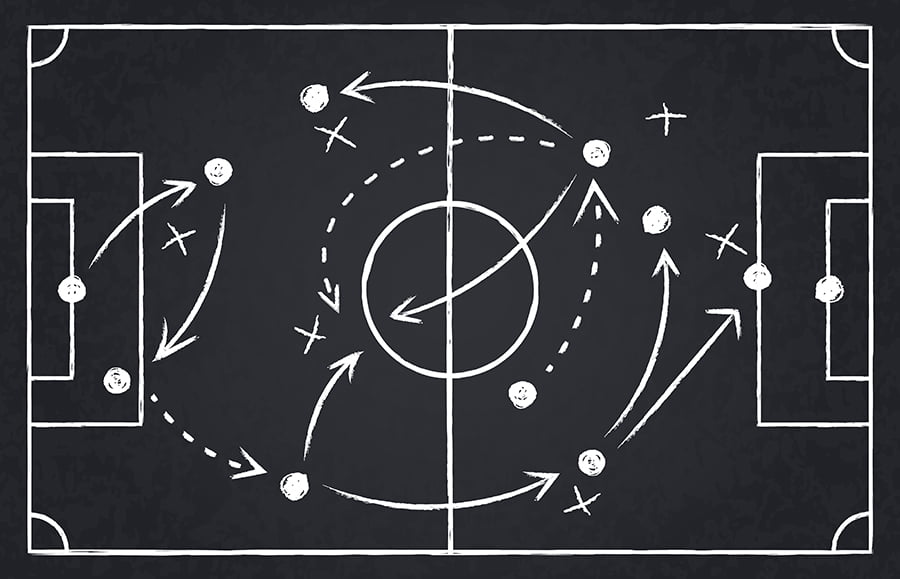
Formation diagrams are an essential part of football chalkboards. They provide a visual representation of how players should be positioned on the field during different phases of play, such as attacking, defending or transitioning.
Coaches use formation diagrams to communicate their tactical ideas and strategies to players before games or during training sessions.
There are many different formations that teams can use depending on their playing style and strengths. Some popular examples include 4-3-3, 4-2-3-1, 5-3-2 and 3–5–2 formations.
Each formation has its own advantages and disadvantages in terms of defensive solidity, attacking threat and midfield control.
When creating a formation diagram on your football chalkboard it is important to consider the roles each player will have within that system. For example, in a traditional back four defense (four defenders), there may be two center-backs who focus primarily on stopping opposition attacks while fullbacks push up into more advanced positions when the team is in possession.
Player Positioning
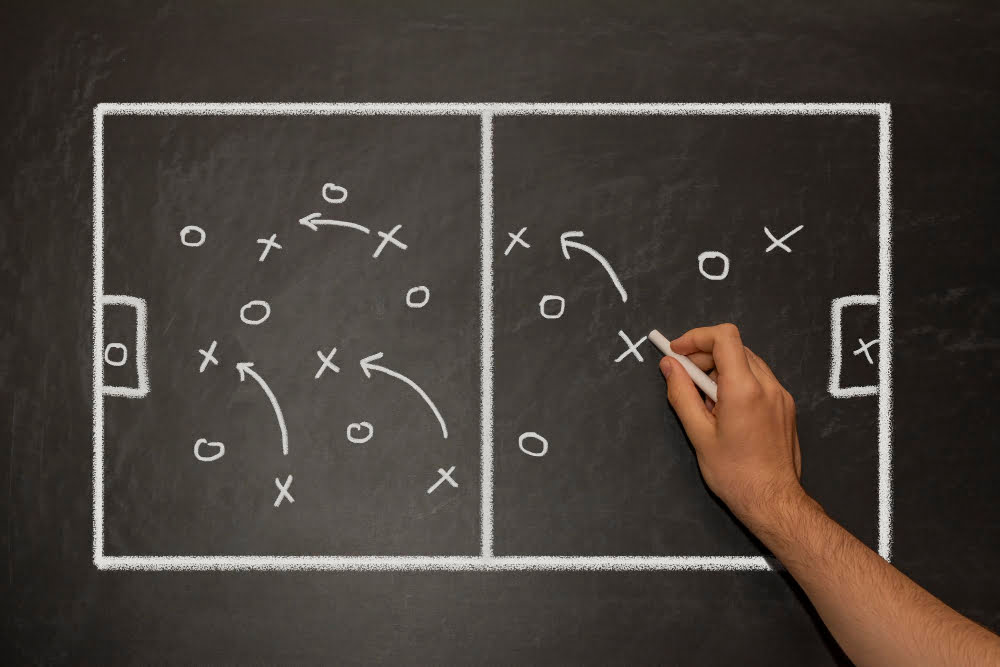
Coaches use the chalkboard to illustrate where each player should be positioned on the field during different phases of play, such as attacking, defending, and transitioning. For example, in an attacking phase, forwards may be instructed to stay high up the pitch while midfielders push forward to support them.
Defenders may drop back into their own half when under pressure from opponents.
It’s important for players to understand their roles and responsibilities within these positions so they can work together effectively as a team. The chalkboard allows coaches to visually demonstrate how players should move around the field in relation to one another and adjust tactics accordingly based on opponent strengths and weaknesses.
Set-piece Strategies
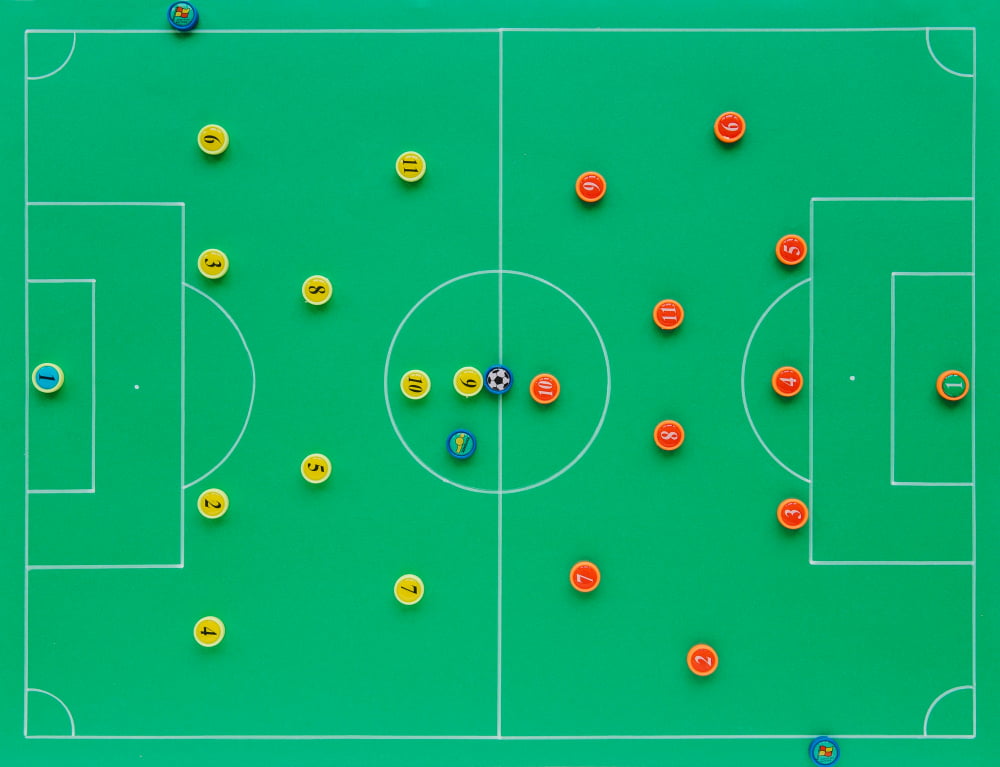
A well-executed set-piece can be the difference between winning and losing a game. Coaches spend hours analyzing their opponents’ weaknesses to come up with effective corner kick, free-kick, or throw-in routines.
One popular set-piece strategy is the “dummy run.” This involves one or more players making a decoy run towards the ball before peeling off at the last moment to create space for another player to receive it unmarked.
Another common tactic is “overlapping runs,” where two players overlap each other’s positions during a free-kick or corner kick routine. This confuses defenders and creates opportunities for crosses into dangerous areas.
Defensive Drills

These drills help players develop their defensive skills, including marking, tackling, and intercepting passes. One effective drill is the “one-on-one defending” drill where a defender must prevent an attacker from scoring in a one-on-one situation.
Another useful drill is the “defending as a unit” exercise where defenders practice working together to close down space and block passing lanes.
The “zonal marking” technique can also be practiced through various drills such as the 4v4 game with two neutral players or 6v6 game with three neutral players. In this way, defenders learn how to cover specific areas of the field rather than just individual opponents.
Attacking Patterns

These patterns can be designed for specific situations, such as attacking from the wings or breaking down a compact defense. They involve coordinated movement and passing between players, often with the aim of creating overloads in certain areas of the pitch.
One common attacking pattern is known as “the overlap.” This involves a full-back making an overlapping run beyond a winger who has cut inside towards goal. The winger then plays a pass into space behind the opposition’s defensive line for the full-back to run onto and deliver a cross into the box.
Another popular pattern is called “the one-two.” This involves two players exchanging quick passes with each other, allowing one player to break through an opposing defender’s position while receiving back possession from their teammate.
Effective attacking patterns require precise timing, good communication between teammates, and well-executed individual skills.
Pressing Triggers

These can be identified by analyzing the opponent’s playing style and tendencies, such as their preferred passing lanes or individual player weaknesses. Pressing triggers can also be situational, for example, when an opposing defender receives a back pass or when they are forced into making a long ball due to lack of options.
By identifying and executing pressing triggers effectively, teams can disrupt their opponents’ rhythm and regain possession in dangerous areas of the pitch. It is important for coaches to communicate these pressing triggers clearly with their players during training sessions so that they become second nature during games.
Zonal Marking

This approach allows defenders to focus on their designated zone, making it easier for them to anticipate and intercept passes. Zonal marking can be particularly effective against teams that rely heavily on passing and movement, as it limits the space available for attackers to exploit.
However, zonal marking requires good communication between defenders in order to ensure that there are no gaps or overlaps in coverage. It also requires players who are comfortable with reading the game and positioning themselves accordingly.
Zonal marking can be an effective way of defending when executed correctly but may not suit all teams or situations depending on their strengths and weaknesses.
Counter-attack Plans

A well-executed counter-attack can catch the opposition off-guard and lead to a quick goal-scoring opportunity. To create effective counter-attack plans, coaches need to identify players with pace and good ball control skills who can quickly transition from defense to attack.
The key elements of a successful counter-attacking strategy include identifying the right moment to launch an attack, making quick passes, exploiting space behind the opposition’s defensive line, and having players in advanced positions ready for through balls or crosses.
Coaches should also consider how their team will defend after launching a counter-attack as they may be vulnerable if too many players push forward leaving gaps at the back.
Individual Player Roles

Each position on the field requires specific skills and responsibilities, and it’s important for players to understand their role within the team’s overall strategy. For example, a central midfielder may be tasked with controlling possession and distributing passes to teammates, while a striker is expected to score goals by making runs into space or holding up play for others.
On a football chalkboard, coaches can use symbols or labels to represent each player’s role in different formations. This allows them to easily communicate tactical instructions during training sessions or matches.
By understanding their individual roles within the team structure, players can make better decisions on the field and contribute more effectively towards achieving collective objectives.
Some common individual player roles include:
- Goalkeeper: responsible for preventing opposition from scoring by making saves.
- Full-backs: provide width in attack while also defending against opposing wingers.
- Centre-backs: defend against opposition attackers and help build attacks from deep positions.
- Central midfielders: control possession of ball through passing movements; support both attacking & defensive phases
- Wingers/ wide forwards: create chances through dribbling past defenders & crossing balls into box
- Strikers/ centre-forwards: Score goals either via creating opportunities themselves or finishing off moves created by other teammates
Substitution Strategies
A well-timed substitution can change the course of a game and provide fresh energy to the team. Coaches should have a clear plan for substitutions before the game, considering factors such as player fitness, tactical adjustments, and potential injuries.
One common strategy is to bring on attacking players in the second half when chasing a goal or defending a lead. This can put pressure on opponents who may be tiring or losing focus.
Another approach is to make defensive substitutions late in games when protecting a lead. Bringing on extra defenders or midfielders can help secure possession and limit opposition chances.
Coaches should also consider how substitutions will affect team dynamics and morale. Players who are substituted off may feel disappointed or frustrated, so it’s important for coaches to communicate their decisions clearly and respectfully.
Off-the-ball Movements

These movements refer to the actions of players who do not have possession of the ball but are still involved in creating chances for their team. Some examples include making runs into open spaces, dragging defenders out of position, or providing passing options for teammates.
One effective off-the-ball movement is a diagonal run towards goal from a wide position. This move can create confusion among defenders and allow attackers to get behind them with ease.
Another useful tactic is dropping deep into midfield areas to receive passes from defenders or midfielders before turning and driving forward with the ball.
Coaches should encourage their players to be aware of these off-the-ball movements during training sessions so that they become second nature during games.
Tactical Adjustments
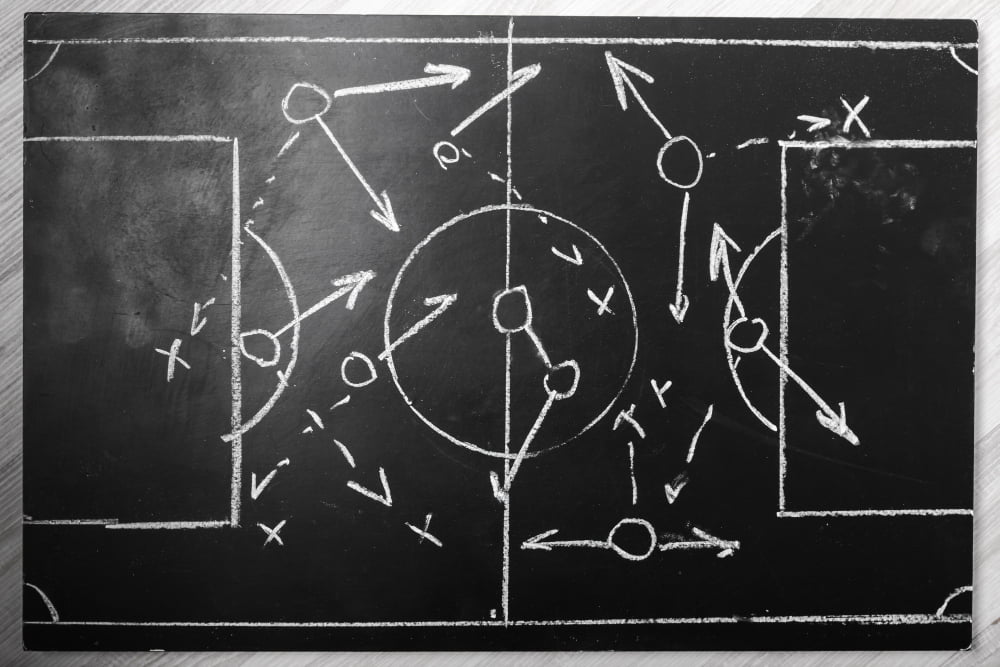
Coaches often use the chalkboard to communicate changes in strategy during halftime or timeouts. These adjustments may include changing formations, player positions, or marking assignments to counteract an opponent’s strengths and exploit their weaknesses.
For example, a coach might switch from a 4-4-2 formation to a 3-5-2 formation if they need more midfield control or opt for man-to-man marking instead of zonal marking if individual players are causing problems for their defense. Tactical adjustments require quick thinking and effective communication between coaches and players on the field but can make all the difference in securing victory.
Game-specific Preparations

Coaches need to analyze the upcoming opponent’s strengths and weaknesses, playing style, and recent form before devising a game plan. This involves studying match footage, analyzing statistics, and scouting reports.
Based on this analysis, coaches can prepare their team by focusing on specific areas of play that will give them an advantage over their opponents. For example, if the opposition is known for its strong midfield presence but weak defense line; then the coach may instruct his players to focus more on attacking down the flanks or through balls behind defenders.
In addition to tactical preparation; physical fitness also plays a vital role in game-specific preparations. The coaching staff must ensure that players are well-rested before games while also being physically prepared for high-intensity matches.
Player Matchups

Coaches often spend hours analyzing the strengths and weaknesses of their opponents’ players to determine the best way to neutralize them. For example, if an opposing team has a prolific striker, the coach may assign one of their center-backs to mark them closely throughout the game.
Similarly, if an opponent has a creative midfielder who likes to dictate play from deep positions, the coach may instruct one of their central midfielders to man-mark them or deploy two defensive midfielders in front of their backline.
In addition to individual player qualities and tendencies, coaches also consider how different players interact with each other on the field when making matchup decisions. For instance, they might look at which fullbacks tend to overlap frequently and which wingers like cutting inside onto their stronger foot.
Defending Corners
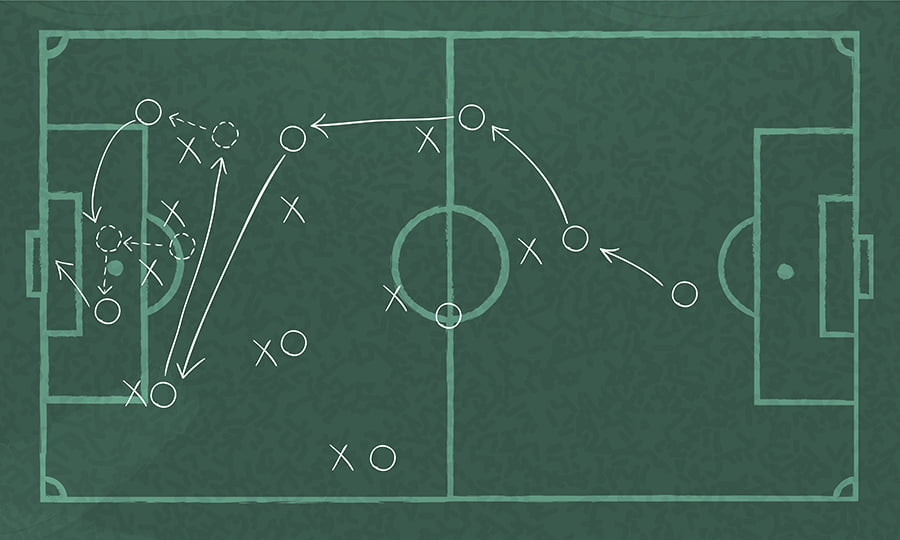
To defend corners effectively, coaches often use the football chalkboard to diagram set-piece strategies and player positioning. One common approach is zonal marking, where defenders are assigned specific areas of the penalty box to cover rather than individual players.
Another strategy involves man-to-man marking, where each defender marks an opposing player in their designated area.
It’s important for defenders to communicate with each other during corner kicks and stay alert for any unexpected movements from opponents. Coaches may use training sessions on the chalkboard to practice defending different types of corner kicks such as inswingers or outswingers.
Creative Free-kick Routines

There are many different types of free-kick routines that teams can use, such as decoy runs or unexpected passes. One popular routine is the “dummy” where one player pretends to take the kick but instead leaves it for another player who takes a shot on goal.
Another option is to have players line up in unusual positions before running into space when the ball is kicked.
It’s important for teams to practice their free-kick routines regularly so that they become second nature during games. Coaches should also consider factors like distance from goal and angle when deciding which routine will work best in each situation.
Attacking Combination Plays

These plays involve multiple players working together to create scoring opportunities by passing and moving in coordinated patterns. Some common attacking combinations include one-twos, overlaps, and through balls.
One effective combination play is the give-and-go or one-two pass. This involves a player passing the ball to a teammate before quickly running forward to receive it back in space behind the opposition defense.
Another popular attacking combination is an overlap between two players on either side of the field. The first player will run with the ball towards their teammate who has made an overlapping run past them, allowing for a quick exchange of passes that can catch defenders off guard.
Through balls are also commonly used as part of attacking combinations where midfielders or forwards look for gaps in opposing defenses and send long passes into those spaces for teammates to run onto.
High Line Vs. Low Block

A high line is when the defenders play closer to the halfway line, leaving less space between them and the opposition’s attackers. This strategy is often used by teams that want to press high up the pitch and win back possession quickly.
However, it can be risky as a single mistake or lack of pace from a defender can lead to an easy goal for the opposition.
On the other hand, a low block involves defending deeper in your own half with more players behind the ball. This strategy aims at denying space for opponents’ attackers while waiting for opportunities on counter-attacks or set-pieces.
It requires discipline and patience but can be effective against stronger attacking sides.
Training Session Outlines

They provide a clear structure for the training session and ensure that all aspects of the game are covered. A good training session outline should include warm-up exercises, technical drills, tactical work, and cool-down activities.
The warm-up should focus on getting players ready physically and mentally for the upcoming practice while also helping to prevent injuries. Technical drills can be used to improve individual skills such as passing accuracy or shooting technique.
Tactical work involves practicing team strategies like pressing triggers or set-piece routines in a controlled environment before implementing them in games.
The cool-down phase is just as important as warming up since it helps reduce muscle soreness and prevents injury after intense physical activity during practice sessions.
Half-time Adjustments
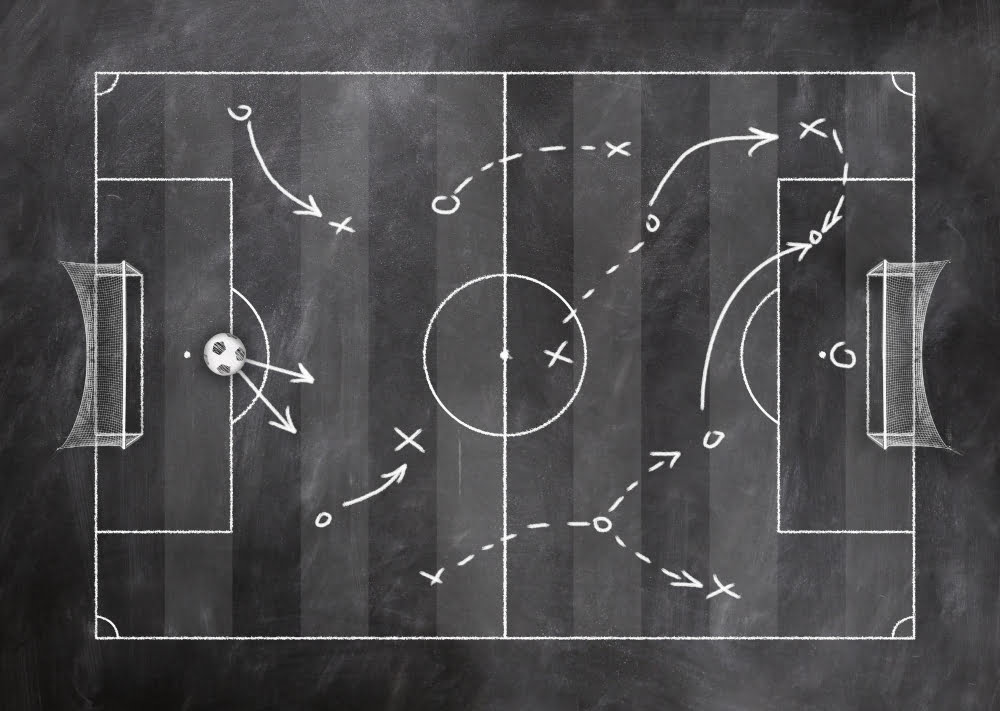
Coaches use this time to analyze the first half and make necessary changes to their team’s tactics, formation, or personnel. The chalkboard can be a useful tool for coaches during halftime as they can visually explain their ideas and strategies to the players.
Some common half-time adjustments include changing formations, substituting players who are not performing well or have received yellow cards, adjusting pressing triggers based on opponents’ movements, tweaking set-piece strategies based on what worked in the first half and what did not work.
It is important for coaches to communicate these adjustments clearly with their team so that everyone understands what needs to be done differently in the second half of the game. With proper use of a football chalkboard during halftime analysis sessions by coaches will help them convey information more effectively which could lead towards better performance from teams after making those necessary changes at halftime break.
Recap:




